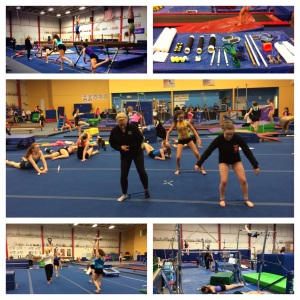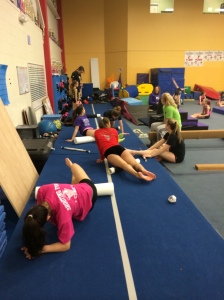This week I wanted to share an injury situation that recently came up with one of our gymnasts, and touch on some areas I’ve been thinking on the last few months. I really think people in gymnastics would benefit from hearing and thinking about her story. Don’t worry, both her mother and her said it was okay if I posted about it. After discussing it with them they agreed it was important information to share for other gymnasts and coaches out there. The situation is certainly a bummer as I will talk about, but I think there are some larger concepts behind the story that a lot of coaches/gymnasts/parents/medical professionals could learn from to help other gymnasts out there. I had another post lined up for this week but I thought this one was more important to get out. So, I did a little late night 2 am writing session (thank you Dunkin Donuts) and put this together for and early post this week.
Category: Integrated Pre-Hab
There are certain areas that gymnasts can develop tightness and stiffness in, due to the nature of the sport, how we train, and other factors related to our daily movements. I know as soon as some people hear “gymnast” they assume the athlete has rubber band like mobility all over. Even though there are a lot of gymnasts who are pretty mobile, there are plenty of gymnasts who develop certain areas that tend to wind up. These same concepts also create excessive strain on other areas of the body that have to pick up the slack, often times becoming an area that breaks down and can become and injury. The lower back may be making up for tightness in the front of the hip during bridging skills, the shoulder may be making up for restricted extending movement in the middle spine during handstand work, and so on. Overtime if these areas are not addressed they can create large imbalances and compensations to occur, which can really throw off a gymnast’s mechanics.
Last week in Part I of this post I outlined my thoughts on what some contributing factors may be to a gymnast suffering an Achilles tear. I talked about some of the aspects related to the forces of gymnastics, biomechanical problems a gymnast may have like missing mobility, jumping and landing techniques, and factors related to the sport of gymnastics itself. I wanted to follow up this post with this weeks article offering some ways that I think people can benefit from using to be pro-active about it, especially as competition season starts to ramp up. The first step in preventing an injury like an Achilles tear is to get educated about the pieces of the puzzle involved. Then with this information, coaches and gymnasts can understand the reasoning behind why they should use pre-hab techniques directly during their training.
The high rate of Achilles tears in gymnastics is something that has always blown my mind. As a gymnast going through high school and college, it seemed that every few months I heard about someone else loosing their season because they ruptured their Achilles. With new research and lots of information coming from people in the sports medicine side of gymnastics, a lot of great progress has been made to educate people about information regarding this problem. Unfortunately, the issue still continues with recent reports of Bri Guy from Auburn tearing both her Achilles at the same time last week, an Achilles tear from Sam Peszek earlier this year, a hand full of college and international gymnasts, and I’m sure many more across the sport. It started to get the gears of my brain turning about what else maybe goes into the problem, and some ways that I may be able to offer some knowledge for coaches and gymnastics to use preventively in their training.
Then two months ago a gymnast I knew from a camp contacted me saying she tore her Achilles doing a full-in on floor, a skill she has done hundreds of times before. She was asking about the treatment and surgery, what her rehabilitation process would be for the year, and her hopes of continuing gymnastics for her last few college years. I took the opportunity to ask her a lot of questions about how her training was going before it happened, if she had other pains or injuries that were ongoing, the road leading up to her injury, and a lot of other stuff. I scribbled all of the things we talked about down on a napkin, got out all the research/books I had related to Achilles tears, and then took a few hours after to map out some of the ideas I had brewing. After this process I looked at all the pages I had out and started to notice that there may be a lot more to it than meets the eye. Along with this, I found that a lot of the contributing factors may have preventative steps that coaches and gymnasts could be using during their training.
A few weeks ago I got asked to do a podcast interview for Gymnast Care with Dr. Josh Eldridge, and I’m really excited to share that it got released today through his website. I have been talking a lot with Josh in the last few months for how to help gymnasts reduce injuries and perform at their best. We talk about tons of good stuff including my background and why I started my blog, what the pre-hab model is about, how PT can help gymnasts, some common gymnastics problems/injuries, how coaches can use the info from my blog in their gyms, and much more. I’m really thankful and grateful for the opportunity from Gymnast Care, use this link to find the podcast:



































































